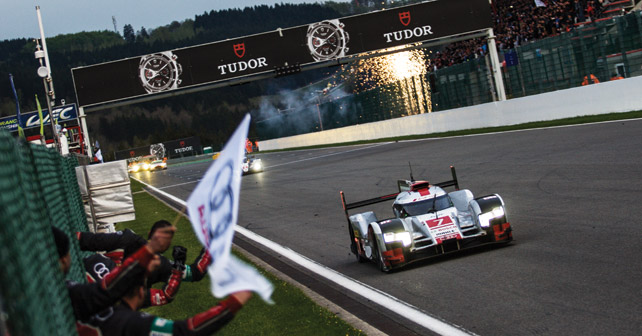Audi’s win at Spa with the team of Andre Lotterer/Marcel Fassler/Benoit Treluyer is at the same time an ominous warning for defending FIA World Endurance champions Toyota and welcome news for neutral followers of endurance racing who have been abuzz ever since Porsche announced their entry into the LMP1 class of the WEC.
There was just 13.424 seconds between the winning Audi and the factory Porsche team of Romain Dumas/Neel Jani/Marc Lieb after six hours and 176 laps of racing around the 7.004 km Spa-Francorchamps circuit. If that is not an enticing teaser to the next round of the championship – the iconic 24 Hours of Le Mans – then nothing really is.
Porsche and Audi locked out the first four places in the overall results while the best effort of Toyota could net just a fifth place (they had won this event last year) and the much publicized Nissan LMP1 entry had to miss both Spa and the preceding round at Silverstone in order to test their eye-grabbing GT-R LM Nismo a continent away in Bowling Green, Kentucky in America.
LE MANS PECKING ORDER
While it is tempting to give Audi the benefit of the doubt in their attempt to win their 14th 24 Hours of Le Mans in 16 years in mid-June, it is worth noting that prior to the start of this season, Porsche admitted that it would struggle to match its VW Group ‘relative’ due to a different approach to energy storage.
Having increased the amount of energy that can be stored in its 919 Hybrid’s batteries from 6 megajoules to 8 megajoules a lap this year, Porsche stated that the full potential of this move would be more apparent at the 13.629 km Circuit de la Sarthe that will be the venue of the famous 24 hour race.
The circuit’s layout is by and large similar to that of a highway with intermittent sections where heavy braking aids in energy recovery and storage, following which the same energy is released to give a prototype car in the LPM1 hybrid class a big boost during acceleration.
A DIFFERENT BALL GAME
It is a feature that was not fully apparent at races like the six hour events at more twisty circuits like Silverstone and Spa where Audi had the edge in terms of handling.
Audi have doubled the energy storage capacity of its R18 e-tron quattro’s batteries but still remain at 4 megajoules while Toyota’s TS040 Hybrid remains at the 6 megajoules mark as they did last year.
Of course with increased energy storage and release comes the risk of greater unreliability, which is essentially what the 24 Hours of Le Mans is about. A near 5,000 km odyessy that puts drivers and crew members under grindstone for an intense 24 hours.
Nissan’s approach will theoretically give it an edge in terms of traction as its front-engined, front-wheel-drive layout will put the drive directly at the front tyres which will also have the weight of the engine over them.
The Japanese firm has also aimed to run in the 8 megajoule energy recovery class. And this is all in the first year with a radical approach.
Truly a case of ‘no guts, no glory’. Either that or a slick and attention grabbing marketing campaign. Regardless, it should be worth following.




























Write your Comment